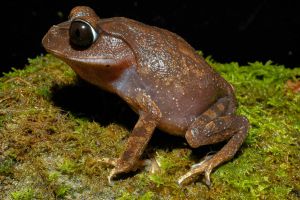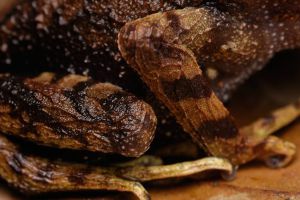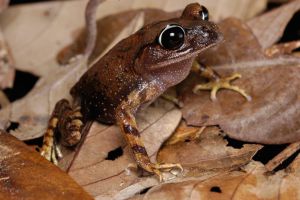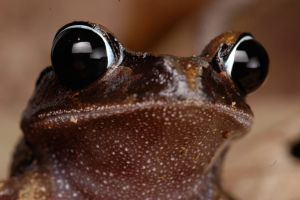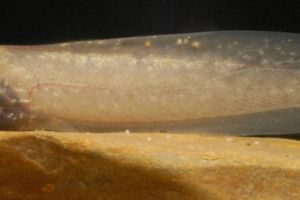
Frogs of Borneo

Frogs of Borneo

Frogs of Borneo

Frogs of Borneo

Frogs of Borneo

Frogs of Borneo

Frogs of Borneo

Frogs of Borneo

Frogs of Borneo

Frogs of Borneo

Frogs of Borneo
Bornean Families
Leptobrachium:
montanum
Montane Large-eyed Litter Frog
Leptobrachium montanum lives in the primary montane forests above approximately 900 m asl up to 1.600 m. At its upper end of the elevational range, it is occurs together with morphologically indistinguishable L. gunungense in the same habitat at Gunung Kinabalu.
This frog is brown above and mimics dead leaves. Limbs display black bands. The belly is lighter than the back, sometimes grayish. The eyes are large and popping and appear black because the iris is very dark brown. The iris surrounded by a white sclera outside the pupil. The head is broad indicating the ability to engulf larger prey objects. Outside the iris the eye sclera is white. Finger and toe tips are blunt (pointed in L. ingeri, L kanotwitensis). Females usually range approximately from 49 to 72 mm in snout-vent length (SVL), with some reports even up to 63–87 mm; males are smaller, around 56–65 mm SVL.
The tadpole of L. montanum is found in small to medium-sized mountain streams with rocky stream bed. As the other species in the genus, tadpoles grow big (> 70 mm). Tadpoles can be seen during the day, but seem more active at night, especially the larger tadpoles hide under rocks during the day. Although living in streams, these tadpoles are not adapted to strong currents and prefer quiet stream sections. The tadpoles are large and possess a strong tail with well developed tail fin. The snout is relatively long and blunt. Early stages have only a few dark spots on the tail. As tadpoles grow, the number of spots increases and the tadpoles become darker in general. The skin has a iridescent shine. If there are reliable morphological characters to distinguish larvae of montanum from gunungese is unknown. Tadpoles from both species are very similar.
The advertisement call is a series of loud "quak". Often beginning of rainfall in the afternoon triggers groups of males to initiate calling.
Version tracking
-
30.07.2025
upgrade images
